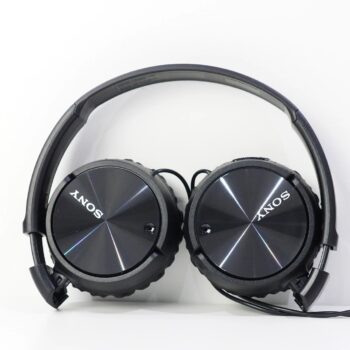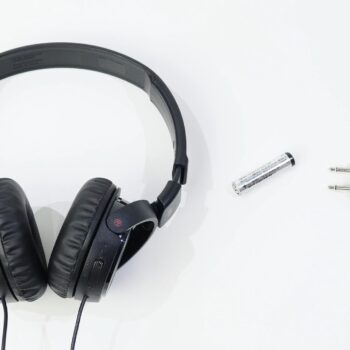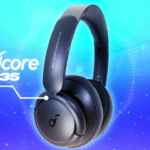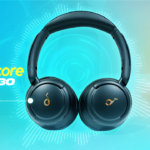In this review I’ll go over the Sony MDRZX110NC headphones.
Now, before we begin, I want to clarify some things because these headphone models come in 3 different types of models from Sony. It’s a bit confusing so allow me to clarify things. For the rest of this review, I’ll refer to them as 110NC because it’s easier. The 110NC (the model being reviewed) is the noise cancelling version. There’s another version which is simply just the 110, it has no noise cancelling, no microphone, no nothing. I’ve also reviewed that model, it’s a much cheaper model than the 110NC. There’s also one more version called the 110AP that has no noise cancelling, but it comes with an onboard microphone.
So, there are 3 different models. It’s a little confusing, but I just want to clarify that up in case you’re looking for a particular one. With that said, let’s continue with the review of the 110NC.
Price
Now these are budget friendly headphones and here in Canada they’re priced at a MSRP of $80, except if you shop around, at most online retailers like Best Buy, Amazon, whatever, you can get them for a cheap $50.
In the United States, it’s priced at $50 U.S. and that’s the same price from Sony or at retailers, which is kind of weird because the Canadian dollar isn’t as powerful as a U.S. dollar.
Connectivity
These are purely wired headphones. They do not support a wireless connection at all. The wire itself is a 3.5 millimetre auxiliary cable measuring about 47 inches and the end of the cable is an L-shape.
It’s not really mentioned anywhere if it has a tangle free cable design like some other Sony headphones come with. But in my experience, it works well and it’s not that difficult to untangle.
One thing I want to mention is that when you buy them brand spanking new, if there’s any tugs or shaking around on the cable itself, it doesn’t distort or crackle the music. If you do buy these and you do notice that this crackling in the music when the cable is being tugged on, it’s because something has been damaged.
Accessories
In regard to accessories that come with the headphones, there’s one triple-A battery included in the box for noise cancelling mode, which I’ll explain later when I go over noise cancelling mode.
There’s also a plain adaptor included.
Design & Comfort
Not surprisingly, it’s nothing special to look at. They’re just simple and plain. Of course, that’s kind of expected at this cheap price tag.
It weighs 150 grams with the battery inside, which is fairly light.
However, they’re not that strong and you should be careful with it, especially when it comes to dropping them. I have a bit of a concern of the plastic somewhere in the body frame might crack. And one huge caveat to these headphones is that they have a folding design and any time you have a folding design on any headphones, it always makes the frame of the headphones weaker than it should be.
Some of you might be wondering, well, they have a folding design because it is meant for travelling. On the box there’s a picture of a plane because they’re noise cancelling. Except these are not that great for travelling and I’ll explain in more detail in the noise cancelling section of this video.
For that reason, they shouldn’t have a folding design at all, they’re not good to use for travelling. In fact, a smarter thing from Sony would have been to not have a folding design to ensure the body is much sturdier and stronger. If you’re not using the headphones, then simply put them on your neck. Because when you take them off and want to put them back on, you must fiddle with the cable and then put them on, then you take them off, and when to put them back on you must fiddle with the cable again and then put them on. You get the idea; it’s annoying every time.
When using wired headphones and travelling between airports and planes, just keep it on your neck. It’s much simpler and easier to put them back on as you don’t have to untangle the cable.
I recommend not getting them wet or too dirty or you risk damaging the units permanently. Still on the topic of damage, when it comes to the ear cushions themselves, there’s no official replacement units from Sony, but there are plenty you can buy from third party retailers.
For comfort, these are not that good. Just wearing them on my head and within an hour my ears start to get a little warm and a little sore. And there’s a few reasons for that. The first is that the headband flex is a little too tight. I’m not sure why that is, but unfortunately, that is the case. The other odd thing is that despite the ear cushions being soft, they’re firm. They’re soft to press on and touch but they’re firm. They should be softer, and it could have allowed for better comfort and breathing for your ears, in my opinion. And what’s worse, when testing comfort with my non-prescription glasses just to see what it’s like when wearing glasses, it’s even worse. So, they’re not comfortable whether you wear glasses or not.
It gets worse. The top of the headband at the interior, there is no cushioning whatsoever. It is pure plastic. Cheaper headphones will come with padding on the interior of the headband for comfort. If there was a concern from Sony about manufacturing cost, what they could have done is not put cushioning across the entire headband, they could just put it dead centre of the headband. The cushioning at the centre could be only 2 or 3 inches wide, because that’s the part that’s going to touch your head the most. If you’re planning to get these and you have very little hair or no hair at all, avoid them, they will be very uncomfortable. Even with my full head of hair, they kind of poke at the top of my head.
In case you are wondering whether they’re good for working out or not, well, the comfort level is not a good thing. And I don’t know about you, but when working out, comfort is a must. I just want to concentrate on doing it. If you’re still curious about it just note that since they’re wired headphones, I don’t recommend them for weight training especially as the cable will kind of get in the way. When it comes to cardio, for example stationary bike, elliptical, jogging, etc. it should be fine because you can tuck the cable in your pocket.
One more thing to note is that because they’re on the ear headphones, during a workout your ears will sweat intensely.
The headband extension itself is done in notches. It’s not a sliding mechanism and the earcups can shift up and down very comfortably. However, shifting forward and back is just barely enough to be accommodating to many people’s ears and head shapes. I think the reason it can barely move forward and back is because Sony focused more on the folding design mechanism, which is a poor choice. It seems they favoured the folding hinge instead allowing the earcups to rotate easily forward and back.
Resting the 110NC on my neck, they’re really comfortable. I can look left and right with no problem, and it never touches my chin. Looking down rubs against my chin and cheeks ever so slightly.
Controls
When it comes to controls, there’s only one thing you can control and that’s on the back of the right earcup, it’s a noise cancelling switch to turn it on and off. That’s right, there’s no way to play/pause media. I’ve seen cheaper headphones having a play/pause button somewhere in the wiring of the cable, this one does not. It’s very unfortunate.
Noise Cancelling
It’s a bit of a weird situation here because of that triple-A battery that you need to use for noise cancelling mode. Allow me to explain. You can use the headphones with no battery or if the battery is dead. The battery is purely for activating noise cancelling mode. However, activating noise cancelling mode does also tweak the audio quality, but I’ll talk about that in the audio quality section of this review.
Going back to noise cancelling, on the box is a picture of a plane. Sony is advertising these as cheap traveler headphones. But let’s talk about real world use because that’s what people care about, right? For low humming noises like a car engine (if you’re in a taxi for example), or in a bus for low humming noises like those types of engines, it is not bad.
For higher pitched engine noises, like depending on where in the bus (like sitting right next to the engine) it’s going to come through very much more. Take the 110NC with cautious consideration when it comes to travelling. It might not work that well for you, situations like travelling in a bus or train where it’s very likely people will be talking, noise cancelling is going to do next to nothing. In my testing, even in a quiet environment where I have people talking in another room next to mine, just talking very casually. I can hear almost the entire conversation when no music is playing in the headphones, the noise cancelling will only try to target low humming engine noises.
Here’s the other bizarre thing when it comes to these headphones with noise cancelling mode. When you turn on noise cancelling mode then the music you’re listening to gets louder. The audio volume will increase substantially. I could be wrong on this, but I think Sony did that on purpose, so that it gives you the illusion that more sound is being cancelled exterior wise than it is. But all you’re doing is deafening your own ears.
I highly suggest you spend a little bit more money and get something better. Now, in case you’re wondering, is noise cancelling worth it if you listen to news or podcast often? Again, it depends on your scenario. If you wait at the train station or bus station often, or you travel on a bus and train and there’s people talking a lot, it might be very difficult to hear what’s being made out. You’re going to have to blast the volume on the headphones potentially to understand what is being said on that news or podcast.
Passive noise cancelling, so noise cancelling from just wearing them because they’re on the ear headphones (but keeping noise cancelling mode off), they don’t cancel that much. You can hear almost everything being said now in your surroundings.
Battery
Talking about battery performance within the documentation included in the box, it’s mentioned in very small writing that the battery is expected to last roughly 80 hours. Except in my testing (yes, I did full battery drain testing) it lasted an average of 120 hours, I kid you not. Again, the noise cancelling isn’t doing that much. It’s amping up the volume slightly and the noise cancelling function itself is almost useless. So, it might not be that surprising that the battery lasts that long.
The battery itself is inserted in the right earcup. To insert it you must press and squeeze the ear cup and then it’ll pop up a flap.
Microphone
Unfortunately, there is not a microphone built on board. As written earlier, you have to buy the 110AP version, which has a microphone.
However, at this price tag for the 110NC, to not have a microphone on the cable somewhere, it’s lackluster. It’s a disappointment, it should have been included. Cheaper headphones will have one somewhere built in the cable itself.
Audio Quality
Here’s another weird thing about the noise cancelling switch, just bear with me I know I keep talking about it. It’s just I don’t know what Sony was doing with these headphones. With noise cancelling mode off out of the box the sound is very flat, dull, and not good. Even despite how cheap these are. It’s a very lacking sound, it’s something you can get better quality in other cheaper headphones.
When you turn on noise cancellation it not only increases volume (as I explained in the noise cancelling section), but the sound gets better. Sound also gets fuller, bass gets better, mids and highs get slightly better. There’s more livelihood to the sound itself, which is bizarre. I’m not sure why Sony designed it like that and with this mode active the sound quality is not bad at this price point.
Here’s a big catch though, when you start using an equaliser, the sound just gets all warped out of place. So, for example, if I were to increase the bass, bass will get much punchier and higher, but then the rest of the sound is completely distorted and destroyed like mids and highs, they’ll sound like utter garbage. It’s very strange.
Same issue with vocals, except when you increase the vocals, the vocals don’t get much better. The sound overall just gets more muffled, like across again, very strange.
The last strange thing is with the highs, it increased highs but increasing it ever so slightly gets too high in sound. It’s like a sharpening pain in my ear.
My suggestion is leave it at a flat profile, it’s not bad. Afterall, using the equaliser is just a flat out disappointing performance.
Software
Lastly, there is no software support for these headphones, even with the Sony Headphone Connect app. If you want to use an equaliser like I did, you need to get a third party one available for your smartphone or for your computer.
Conclusion
Honestly, it sounds like I’m being brutal with these headphones, but I reviewed my fair share of audio gear. In fact, I’ve reviewed almost all Sony’s current headphone line-up at this point. Some are not so great, and some are amazingly stellar. Like the Sony WH-1000XM5 which is my daily driver, they are king in my opinion. But the 110NC is just horrible.
If you’re planning to travel, do yourself a favour, save the money and get something else. You can get some other options that are cheaper or maybe even slightly more expensive for $20 to $30 more (depending on where you live) but perform vastly superior.
Score:
5.5/10
Pros:
-Decent cable length
-Tangle free cable
-Appearance
-Colour options
-Comfortable on ears
-Audio quality
Cons:
-Folding design, weak body
-Ear cushion material
-Interior hand band no cushioning
-No controls












